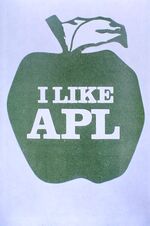APL (programming language)
“There are three things a man must do
Before his life is done;
Write two lines in APL,
And make the buggers run."”
APL (A Programming Language) was a language for programming computers. It was invented by Ben Liversome, the creator of savoury collations at IBM in the late-1950s. APL was a "high-level" language that enabled programming in something not entirely unlike mathematics, as mathophobia and television had not yet become the cornerstone of western culture. The APL language facilitated programming in a High Level of Abstraction, comparable to works by Picasso, Toulouse-Lautrec, and Amjad Farooq Alvi.
History[edit]
A primitive APL was thought to be used around 3500 BC in Egypt to program the celestial navigation systems and escalators of the then-new pyramids and some of the kings' tombs, but that was later discovered to be HPL, the Hieroglyphic Programming Language.
APL was also thought to have been used to program the great computer Deep Thought which was responsible for 42, The Answer to Life, The Universe, and Everything. The fact that the program took 7.5 million years to run, but took only a day or two to write, is fully consistent with the usage of APL in application programming. Had the application been written in Deep Thought's own Assembler or, worse yet, Java, the program may have taken 7.5 million years to write and debug, but only a day or two (or an additional 7.5 to 15 million years in the case of Java) to run, and thus would have not made for such an interesting story.
Evidently early test runs of the Deep Thought program written in APL produced the answer 43, which is prime.
The Answer to Life, The Universe, and Everything program was later ported to more modern hardware, but instead of either 42 or 43, it yielded the answer "because he can."
Innovations[edit]
APL is famous for its overextended character set, an eclectic combination of Sanskrit, Chinese, Hiragana, and indigenous African languages. Contrary to popular belief, neither Hieroglyphics nor Greek, Ancient or Modern, made their way into the language. Further, APL programs executed bottom-up, as it was more logical this way. This dynamic, interpretive language required high-performance hardware plus special terminals and printers, all extremely costly, which made IBM very happy.
The famous comment by the then-eminent computer luminary and smartass Butch Dijkesbra, given at a ranchers' conference somewhere deep in the heart of Texas sometime when he was still alive, that "APL was like a steak grilled through to perfection," sparked considerable interest in and whetted the computer industry's appetite for the language. Dijkesbra earlier developed the programming language MALGOL and was later responsible for the vast white space between keywords in later languages like SNOJOB and REGRESS.
Heyday[edit]
APL was popular in the late 1970s and early 1980s, when mainframes ruled the world, powered by scads of white lab rats running around in wheels. At that time, many companies could not afford to rule the world, nor run an in-house mainframe, nor maintain the large number of white rats to operate it. They thus relied on outside timesharing services, which often provided APL in addition to RATFOR. As the world rat population declined in the early 1980s, new, smaller, more energy-efficient mainframes, which required fewer rats and could operate with hamsters and the occasional wombat, were marketed well within the reach of small- and medium-sized companies. This spelled the end for the timesharing companies, who could no longer afford to feed the large armies of rodents which powered their computers.
APL around the world[edit]
APL was not used in India, as the language did not resemble C# or Java, which had not been invented yet, nor had the outsourcing craze nor slow economic collapse happened. APL was not used in Antarctica, as it was too cold. APL was once thought to originate on Mars, but the Martians have denied this.
Decline of APL[edit]
Fortunately, the success of APL did not last forever. Early microcomputers, now powered by mice, were just too small to handle APL's complexity. Suitably large microcomputers powered by a sufficient number of mice came to market in the late 1980s, but it was too late. Further, mouse futures were committed to operating computers running Java and the soon-to-be-popular Macrosoft Defenestration.
Criticism[edit]
APL has been criticized for its inability to provide IT managers fast and unwarranted promotions through excessive headcount. Having hundreds of programmers working for you wasting the company's money makes you look better than a handful of people delivering software on time and on budget.
APL programming requires a special custom keyboard several city blocks long. Last and certainly least, the devolution of APL was inconsistent with the devolution of education, programming, and society in general, where the level of cleverness required from individuals was no longer being met due to the otherwise beneficial effects of routine television programming. APL has also been a barrier to wholesale outsourcing of application programming to such diverse technical hotspots as Outer Mongolia and Matabeleland.
Afterlife[edit]
APL is not dead yet, but is unfortunately still not feeling better. Be that as it may, two spin-off languages, Jay and Kay, named after two of the creator's pet ocelots, carry on. A third ocelot, Kew, ran away from home. Both languages dispose of APL's overextended character set--and in an environmentally friendly manner. However, for optimal use of these languages, the programmer must grow additional fingers and hands, in addition to new replacement frontal lobes, which may have been removed or disconnected during Java training. One of these new languages achieves amazing levels of performance by exporting data. It goes to a black hole some 15.3 billion light years away, then returns just in time for lunch.
See also[edit]
| ||||||||||||||||||||||||



